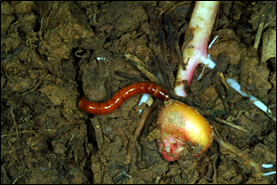Wireworm
Wireworms
Description
The larval stage is the destructive stage; larvae may remain in the ground up to six years feeding on roots of

Wireworm
University of Kentucky Dept. Entomology
grasses and other plants. Most wireworm larvae are hard, smooth, and chestnut brown. They vary from 1/2 to 1-1/2 inches in length when grown. Some species are soft, and white or yellowish in color.
The adults, called click beetles, become active in the spring. This is when they lay their eggs. They are usually brown streamlined beetles, with the body tapering toward the rear. The joint between the thorax and abdomen is loose and flexible, and, when beetles are placed on their backs, they click their abdomen against the ground to toss themselves several inches into the air and flip over.
Damage
Although economic wireworm damage to field crops is rare, when they are a problem they can be very destructive and difficult to control. They are usually found attacking crops planted on ground that has been in sod for several years, or the second year following sod. However, wireworm populations may be reduced by half after the second year following sod. Land that has been in continuous bluegrass sod is more likely to have high numbers of wireworms than fescue sod.
Crops attacked by wireworms have reduced plant populations, since they feed on the seeds prior to germination or just after germination. The plant stand may continue to deteriorate, because wireworms bore into underground portions of the stem, causing plants to wither and die. They continue to feed upon the small roots of many plants throughout the season.
IPM Techniques and Scouting Procedures
- Since the wireworm causes damage by boring into seeds or into the base of the seedling, fields should be checked for wireworms before planting. Bait stations are used to check for wireworms. Two stations are recommended per acre.
- Bait stations, which are really solar traps, are made by digging a hole 4 inches deep and about 9 inches wide. You will need to place 1/2 cup of untreated corn/wheat mixture in the bottom of the hole. The hole is then filled with loose dirt. See Figure I. Do not pack the dirt. The area should then be covered with plastic. Gases produced by the breakdown of the corn/wheat mixture will attract wireworms to the station.
- Stations should be set at least 3 weeks before your planned planting date. The stations should be checked by digging them up in about 2 weeks. You need to record the number of wireworms found in each station.
- Fields can also be checked by digging 5 random samples. Be sure to sample suspect areas. Samples should be 1 foot square and 6 inches deep. This type of sampling should also be done before corn is planted and the number of wireworms in each sample should be recorded.
- Economic Threshold: If you find one or more wireworms per bait station, use a soil insecticide at planting. Rescue treatments after damage is visible are not effective. If damage is sufficient to justify replanting, a soil insecticide should be applied during replanting. Time periods, recommendations and sizes of bait stations were developed by the Illinois Cooperative Extension Service.
References and Additional Information
- IPM-2 Kentucky IPM Manual for Corn
- ENTFACT 120 - Wireworms


